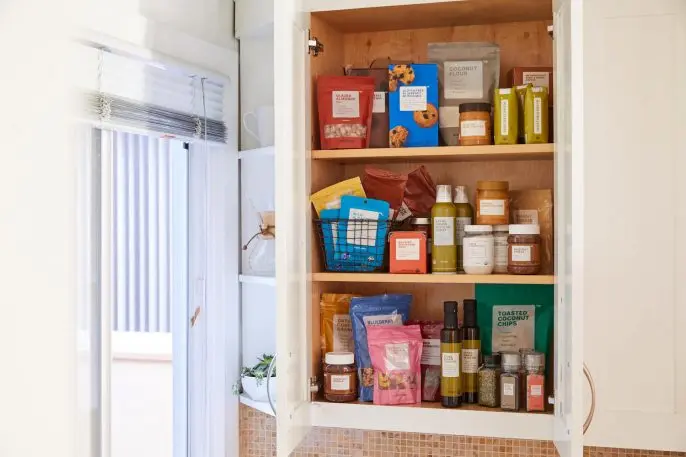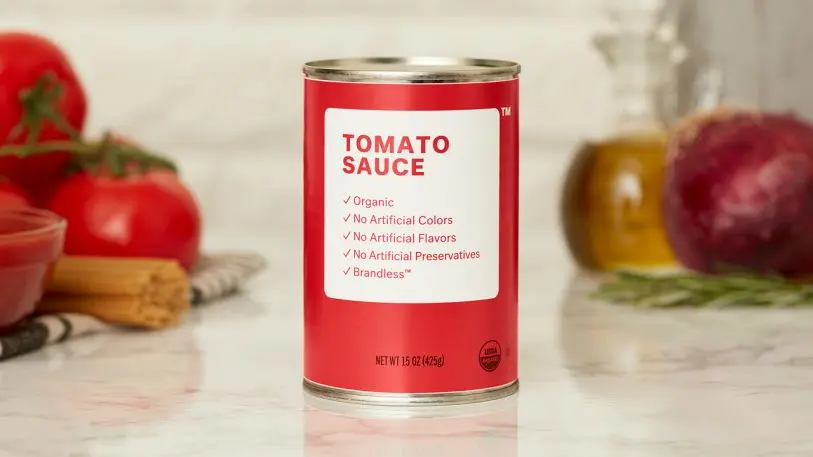Jen Tank is head of creative at Brandless, a direct-to-consumer company that sells groceries and household products. She spoke to Doreen Lorenzo for Designing Women, a series of interviews with brilliant women in the design industry.
Doreen Lorenzo: How did you end up as head of creative at Brandless?
Jen Tank: After earning my BFA at Virginia Commonwealth University, I started my career as a web designer (that’s what it was called in the early aughts) and bounced around a few small design shops in L.A.: The Groop, Hello Design, and an agency sadly named Genex. After some experimentation, I finally found a place I really loved, and spent about half my career at Huge, an agency that was focused on digital transformation for big Fortune 500 brands.
Two years ago, I reconnected with an old friend who was working on Brandless while it was still in stealth mode. When he told me about the vision for a disruptive DTC brand focused on profit and purpose, I wanted to be part of it right away. I basically started that same day, sticking around to join a staff meeting with the leadership team. I officially left my job at Huge four weeks later to join the team.

DL: I love what’s happening at Brandless–it’s a different twist on design. How has the strategy evolved?
JT: At Brandless we’re redefining what it means to be a brand, by design. We don’t follow the traditional brand playbook, the one that shows you shiny images of an idealized “lifestyle” that you can have if you just buy their products.
The direct-to-consumer model has also changed the state of creative and design. There was the era of the Agency of Record, where a company used a single agency, usually a traditional ad firm, to execute all of their creative. Then, when digital created more and more touchpoints for people to interact with a brand, companies needed to have a branding agency and product design firm and a social agency and a traditional advertising agency. It became very fractured.
Brandless is vertically integrated. We’re a small design and creative team, and we touch everything. The advertising, packaging design, the site, product photography, the unboxing experience, and so on. Every part of the experience of Brandless is driven by the same design principles.

DL: Creating a “brandless” experience seems like a fascinating challenge.
JT: It is! The Brandless experience is built on a set of shared values: simplicity, sustainability, wellness, kindness, and giving.
DL: Tell us a bit about your design research process.
JT: Putting people first is key. We’re in constant contact with our community. Through social media, customer service, and directly asking for feedback, we’re always listening through all channels. At every touchpoint we’re asking our community to join us in this mission to improve things for everyone, and to also get in touch with us. They email, DM, and even send us hand-written notes.
We have regular full team meetings every week where our customer service team shares what people love and don’t love about what we’re doing and what we’re creating. From the beginning it’s been part of the business and design process to get that kind of feedback. It’s not something that we’re bolting on later into the company.
DL: What feedback have you gotten from the community?
JT: We get tons of direct feedback that influences both our product development and the design and execution of the things that we make. People are asking for organic baby food, gluten-free baking mixes, fair-trade coffee, nontoxic cleaning supplies, tree-free toilet paper, cruelty-free beauty products.

DL: How do you work with your team and lead them to fulfill the Brandless mission?
JT: It’s a constantly evolving process and something I continue to work on. Creativity requires space to play, try things, revise, and talk it out. It’s not a linear process. My job as the creative leader is to set goals for the team and then make space for them to work out the solutions. Making that space, physically and in the timelines, is absolutely critical in terms of leading creatives. If the creative leader doesn’t do it, nobody will and the business priorities will railroad good design.
But we also have to move fast. One of the things that we say here is anything worth doing is worth doing badly. In order to make an impact, you have to ship. To me, shipping is just as important as the big idea, and the big idea has to be there. My advice to designers is you’ve just got to start somewhere. If you get too attached to the perfection of the big idea, you’re not going to move forward.
DL: How much do you involve the designers in the business?
JT: There is a lot of transparency. Brandless is a high-growth company and we have big ambitions. Something that I talk to the creatives about a lot is: What’s going to have an impact and move the mission forward? We look at business results every day.
DL: What are some of your creative and design goals for Brandless?
JT: Right now we’re working on designing an awesome unboxing experience, but I’m super focused on tools and systems. As we grow, we need to take the things that have worked in the first 18 months and scale them. How do we apply our packaging design system to more categories, to the new products that we are releasing every day? How can we create tool kits and style guides that help new designers get up to speed fast? We’re in a constant process of making it better.
DL: What keeps you up at night?
JT: Sustainability. Sustainability is a big challenge, especially when you’re working in the consumables space that Brandless is operating in. Figuring out how to do less damage to the environment is top of mind. Brandless is tackling this in a lot of ways. We’ve designed refillable cleaning solution bottles that don’t require wasting fuel to ship water. Our ops team is testing ways to reuse shipping boxes in new ways.

JT: When I was in my senior year of college, my favorite teacher told me, “Jen, your ideas are great, but your craft is terrible.”
DL: Really?
JT: Yes. And that put me on a 10-year path to really develop my craft as a designer. I think that some people try to skip that 10,000 hours it takes to develop a craft. There’s no way that I could articulate a vision or lead if I hadn’t spent that decade in the nitty-gritty designing websites, posters, products, and that hands-on “in the trenches” work.
DL: What are some of the leadership lessons you learned when you were coming up in the trenches?
JT: What I see is that a lot of designers, especially female designers, lack confidence in their ideas and design instincts. It can be difficult to stand in the face of data and financial pressure and spreadsheets and say, this just doesn’t feel right. But I do that all the time. I’ve earned the trust from our leadership team, and they usually support me.
My advice is to say what you think, because nobody is going to give you permission to have an opinion. As Shirley Chisholm wisely said, “If they don’t give you a seat at the table, bring a folding chair.”
Recognize your brand’s excellence by applying to this year’s Brands That Matter Awards before the early-rate deadline, May 3.
